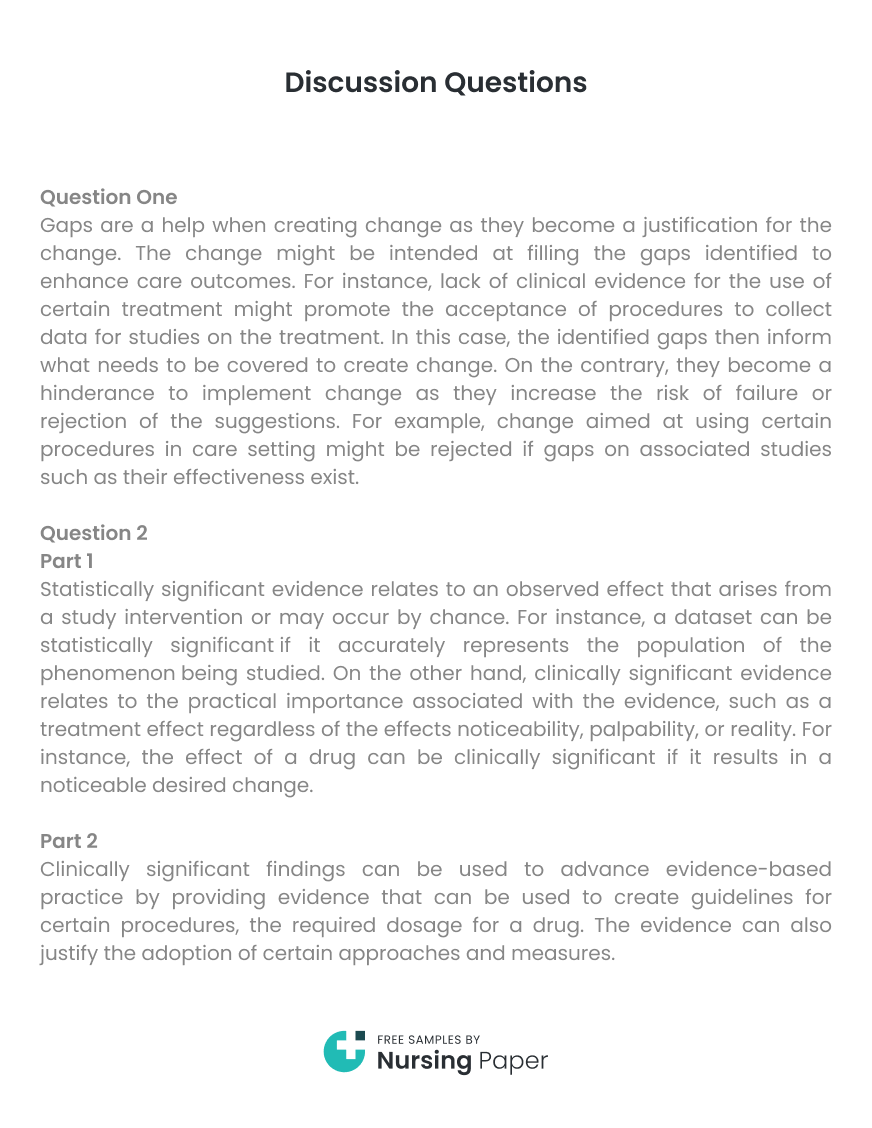
Question 1
Gaps are a help when creating change as they become a justification for the change. The change might be intended at filling the gaps identified to enhance care outcomes. For instance, lack of clinical evidence for the use of certain treatment might promote the acceptance of procedures to collect data for studies on the treatment. In this case, the identified gaps then inform what needs to be covered to create change. On the contrary, they become a hinderance to implement change as they increase the risk of failure or rejection of the suggestions. For example, change aimed at using certain procedures in care setting might be rejected if gaps on associated studies such as their effectiveness exist.
Question 2
Part 1
Statistically significant evidence relates to an observed effect that arises from a study intervention or may occur by chance. For instance, a dataset can be statistically significant if it accurately represents the population of the phenomenon being studied. On the other hand, clinically significant evidence relates to the practical importance associated with the evidence, such as a treatment effect regardless of the effects noticeability, palpability, or reality. For instance, the effect of a drug can be clinically significant if it results in a noticeable desired change.


Part 2
Clinically significant findings can be used to advance evidence-based practice by providing evidence that can be used to create guidelines for certain procedures, the required dosage for a drug. The evidence can also justify the adoption of certain approaches and measures. For instance, in researching about the effectiveness of a certain treatment approach in comparison to another, if clinically significant results are found favoring one approach, the results can be used to justify its adoption over the other.
Part 3
Statistically significant findings are used to advance evidence-based practice by determining the source of an observed effect. The sources are determined through a hypothesis, which is a phrased research question that states the expectations of the researcher about the study. The collected data is then used to confirm or reject the hypothesis. The researchers also phrase a null hypothesis which counters the primary hypothesis. For instance, in a study on the nutritional value of an apple and a banana, a hypothesis would indicate that a banana has more nutritional value while a null hypothesis would indicate the lack of nutritional value between the two. If the results are significant, then the evidence can be used to advance the theory in relations to the banana as source of nutrition, which can be referred to by care practitioners.
Question 3
The shared governance technique includes sharing the value and vision of EBP projects as well as an appeal for involvement is vital for communication in nursing care (Melnyk & Fineout-Overholt, 2015). As such, to effectively reach the staff nurses, I would use print outs and online platforms to communicate the findings. To reach the advanced practice nurses, I would use seminars, online forums, and conferences to communicate the projects. This is important in establishing an EBP culture to continue debates on the subject. To ensure the appropriate audience receives the EBP-related information, I will ensure it incorporated within their agendas, priorities, and responsibilities. In this, multiple forms of communication such as face-to-face, online, and print will be used.

Question 4
I will use the real clinical scenarios data in establishing motivation images for change in clinical practice. I will also strive to gain administrative support for the recognition of EBP as an organizational priority through contacting clinical practice administrators and explaining to them the necessity of an EBP environment to clinical practice settings. I will also form a leadership team by identifying individuals with a zeal for EBP with whom we will spearhead the EBP initiative in clinical practice.
1. Melnyk, B. M., & Fineout-Overholt, E. (2015). Evidence-based practice in nursing & healthcare. (3rd ed.). Philadelphia, PA: Lippincott Williams & Wilkins.



The download will start shortly.

The download will start shortly.
 Subject:
Medicine
Subject:
Medicine  Number of pages: 4
Number of pages: 4  Subject:
Medicine
Subject:
Medicine  Number of pages: 4
Number of pages: 4  Subject:
Health and Social Care
Subject:
Health and Social Care  Number of pages: 3
Number of pages: 3  Subject:
Medicine
Subject:
Medicine  Number of pages: 5
Number of pages: 5  Subject:
Medicine
Subject:
Medicine  Number of pages: 8
Number of pages: 8  Subject:
Nursing
Subject:
Nursing  Number of pages: 7
Number of pages: 7  Subject:
Health and Social Care
Subject:
Health and Social Care  Number of pages: 4
Number of pages: 4  Subject:
Health and Social Care
Subject:
Health and Social Care  Number of pages: 4
Number of pages: 4  Subject:
Health and Social Care
Subject:
Health and Social Care  Number of pages: 29
Number of pages: 29  Subject:
Health and Social Care
Subject:
Health and Social Care  Number of pages: 7
Number of pages: 7  Subject:
Nursing
Subject:
Nursing  Number of pages: 3
Number of pages: 3  Subject:
Medicine
Subject:
Medicine  Number of pages: 2
Number of pages: 2  Subject:
Medicine
Subject:
Medicine  Number of pages: 4
Number of pages: 4  Subject:
Health and Social Care
Subject:
Health and Social Care  Number of pages: 3
Number of pages: 3  Subject:
Medicine
Subject:
Medicine  Number of pages: 5
Number of pages: 5 
